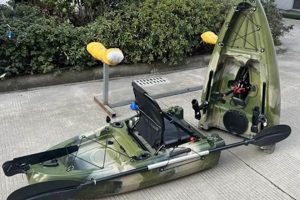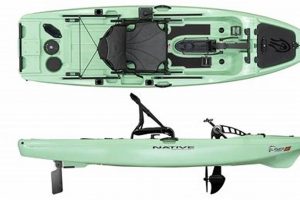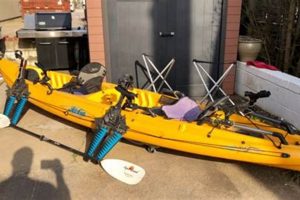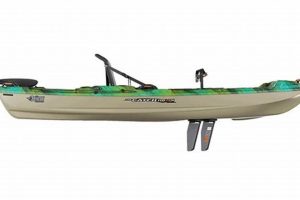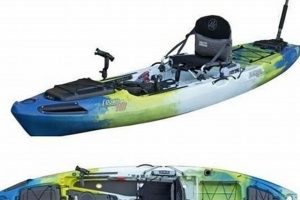Hands-free propulsion kayak angling offers a unique blend of stability, speed, and maneuverability. This approach allows anglers to navigate shallow waters, position themselves precisely for casting, and cover more ground efficiently, all while keeping their hands free for fishing. For instance, an angler can maintain a steady position in a current while simultaneously working a lure or quickly reposition to follow schooling fish.
This style of fishing provides several advantages over traditional paddling. It reduces fatigue, allowing for longer fishing trips. The hands-free operation allows for more efficient lure retrieval and fish fighting. Furthermore, the quiet operation of the fin-driven system minimally disturbs fish, increasing the chances of a successful catch. This evolution in angling has grown in popularity due to its effectiveness and enjoyment, providing a more engaging and active fishing experience.
The following sections will explore specific techniques, equipment recommendations, and ideal locations for maximizing the advantages of this fishing method.
Tips for Hands-Free Kayak Fishing
Maximizing the advantages of hands-free kayak fishing requires careful consideration of several key factors. The following tips offer guidance for improving technique and overall fishing success.
Tip 1: Master Pedal Steering and Maneuvering: Proficiency in controlling the kayak’s direction and speed is essential. Practice maneuvering in open water before venturing into complex environments. This allows anglers to maintain precise positioning and navigate challenging areas effectively.
Tip 2: Choose the Right Fishing Gear: Rod and reel selection should complement the target species and fishing style. Shorter rods are often preferable in kayaks due to limited space. Consider using tackle specifically designed for kayak fishing.
Tip 3: Prioritize Safety Equipment: A personal flotation device (PFD) is paramount. Additional safety gear, including a whistle, signaling device, and first-aid kit, should always be onboard.
Tip 4: Plan and Research Fishing Locations: Understanding water depth, currents, and potential hazards is crucial. Researching target species’ habitats and preferred locations enhances fishing success.
Tip 5: Organize Tackle and Gear Strategically: Efficient organization within the kayak’s limited space maximizes fishing time and minimizes disruptions. Utilizing tackle boxes and storage solutions keeps essential gear readily accessible.
Tip 6: Practice Proper Casting Techniques: Adapting casting techniques to the kayak’s stability and limited space ensures accurate and efficient lure presentation. Practicing casting while seated improves accuracy and minimizes tangles.
Tip 7: Respect the Environment: Adhering to Leave No Trace principles preserves the natural beauty of fishing locations for future generations. Proper disposal of fishing line and other waste is essential.
By implementing these strategies, anglers can significantly improve their hands-free kayak fishing experience. These practices promote safety, efficiency, and environmental responsibility, leading to more successful and enjoyable fishing trips.
These tips offer a foundation for successful hands-free kayak fishing. The following section will delve into specific techniques for various fishing styles and environments.
1. Hands-Free Fishing
Hands-free fishing represents a significant advantage offered by specific kayak designs, particularly those utilizing pedal-driven propulsion systems. This capability distinguishes the experience from traditional paddling kayaks, allowing anglers to focus entirely on fishing techniques and fish handling without the constant need to manage a paddle.
- Enhanced Lure Control:
Maintaining precise lure presentation and depth is often crucial for enticing fish. Hands-free operation permits continuous lure manipulation, allowing anglers to adjust retrieve speed, impart action, and react quickly to strikes. For example, twitching a topwater lure or subtly jigging a soft plastic bait becomes significantly easier and more effective when both hands are available. This level of control can be the difference between a successful hookup and a missed opportunity.
- Improved Fish Fighting Capability:
Landing a fish requires focused rod handling and line management. Having both hands available provides greater leverage and control during the fight, minimizing the risk of line breakage or the fish throwing the hook. This is particularly crucial when battling larger, more powerful species. The angler can maintain optimal rod angles, adjust drag settings, and react quickly to the fish’s movements, all without the distraction of a paddle.
- Increased Situational Awareness:
Maintaining awareness of the surrounding environment is essential for safety and successful angling. Hands-free operation allows anglers to scan the water for signs of fish activity, observe changing weather conditions, and navigate safely through complex environments. For example, spotting a bird dive-bombing baitfish or noticing a subtle surface disturbance becomes easier when not preoccupied with paddling. This enhanced awareness can lead to more strategic fishing decisions and contribute to overall safety on the water.
- Efficient Multitasking:
Hands-free fishing facilitates concurrent tasks, such as adjusting fishing gear, operating electronic devices, or even landing a net. This efficiency is particularly beneficial in dynamic fishing situations or when fishing alone. For example, an angler can quickly switch lures, adjust GPS settings, or prepare a landing net while simultaneously maintaining boat position and control. This streamlined approach maximizes fishing time and allows for a more adaptable and responsive fishing experience.
These facets of hands-free fishing contribute significantly to the overall efficiency and enjoyment of the angling experience. By removing the physical demands of paddling, anglers can dedicate their full attention to the art of fishing, resulting in increased opportunities for success and a more immersive connection with the aquatic environment. This heightened focus and responsiveness contribute to a more dynamic and rewarding fishing experience, particularly within specialized angling disciplines like kayak fishing.
2. MirageDrive Propulsion
MirageDrive propulsion represents a pivotal advancement in kayak fishing, particularly within the context of Hobie kayaks. This unique system distinguishes itself from traditional paddle-driven kayaks through its pedal-powered mechanism, offering distinct advantages in efficiency, maneuverability, and overall fishing experience. Understanding its core components and functionality is crucial for appreciating its impact on this specialized angling discipline.
- Biologically Inspired Design:
Inspired by the efficient movement of aquatic life, the MirageDrive system employs a set of underwater fins that mimic the motion of a penguin’s flippers. These fins propel the kayak smoothly and quietly through the water, minimizing disturbance to fish and allowing anglers to approach fishing grounds stealthily. This biomimetic approach offers a unique advantage in shallow-water environments where traditional paddling can spook fish.
- Hands-Free Operation and Enhanced Fishing:
The pedal-driven nature of the MirageDrive system liberates the angler’s hands for fishing activities. This allows for continuous lure manipulation, improved fish-fighting capability, and enhanced situational awareness. For example, anglers can simultaneously work a lure, adjust drag settings, and maintain boat position without the need to switch between paddling and fishing. This hands-free operation contributes significantly to the efficiency and enjoyment of the fishing experience.
- Maneuverability and Shallow Water Access:
The MirageDrive system provides exceptional maneuverability, particularly in shallow water and confined spaces. The ability to quickly change direction and navigate tight areas makes it ideal for exploring shallow flats, mangrove forests, and other challenging environments often inaccessible to traditional paddle kayaks. This maneuverability provides a distinct advantage when targeting species that inhabit these areas.
- Power and Efficiency:
The MirageDrive system offers efficient and sustained propulsion, allowing anglers to cover greater distances with less effort compared to paddling. This efficiency becomes particularly noticeable in challenging conditions such as strong currents or headwinds. The ability to maintain speed and position without constant paddling reduces fatigue and allows for longer fishing trips. Furthermore, the streamlined design of the underwater fins minimizes drag, contributing to the system’s overall efficiency.
The MirageDrive propulsion system’s distinct advantages contribute significantly to the effectiveness and popularity of Hobie pedal kayak fishing. Its unique combination of biomimetic design, hands-free operation, maneuverability, and power creates a specialized fishing platform that allows anglers to explore diverse environments, maximize fishing time, and enhance their overall angling experience. This integration of technology and design has fundamentally changed the landscape of kayak fishing, offering a compelling alternative to traditional paddling and opening up new possibilities for anglers of all skill levels.
3. Enhanced Maneuverability
Enhanced maneuverability represents a critical advantage in kayak fishing, particularly when utilizing pedal-driven systems like the Hobie MirageDrive. This capability significantly impacts an angler’s ability to navigate diverse aquatic environments, position effectively for casting, and ultimately, increase fishing success. The following facets explore the components and implications of enhanced maneuverability in the context of this specialized fishing style.
- Precise Boat Control:
Pedal-driven kayaks offer precise control over boat positioning, allowing anglers to maintain ideal angles for casting and presentation. This level of control is particularly crucial in dynamic environments such as moving water or windy conditions. For example, holding position near structure or subtly adjusting position to follow a school of fish becomes significantly easier with the hands-free operation and precise control afforded by pedal kayaks. This precision translates to more effective fishing techniques and increases the likelihood of successful hookups.
- Navigation in Confined Spaces:
Maneuverability in tight quarters, such as shallow creeks, mangrove forests, or weed beds, is significantly enhanced with pedal-driven systems. The ability to turn quickly and navigate through narrow passages opens up access to prime fishing locations often inaccessible to traditional paddle kayaks. For example, navigating through dense vegetation or around submerged obstacles becomes significantly easier and less disruptive with a pedal-driven system, allowing anglers to reach secluded areas where fish may concentrate.
- Efficient Course Correction:
Maintaining an intended course, especially in challenging conditions like currents or wind, requires constant adjustment and correction. Pedal kayaks allow for quick and efficient course adjustments without interrupting the fishing process. This capability is particularly beneficial when drifting with a current or maintaining a specific trolling path. For instance, compensating for wind drift or maintaining a consistent distance from a shoreline becomes significantly easier with the continuous, hands-free control offered by a pedal-driven system.
- Quick Response to Fish Activity:
Reacting swiftly to signs of fish activity, such as surface disturbances or bird activity, is often crucial for capitalizing on fishing opportunities. Pedal kayaks enable rapid changes in direction and speed, allowing anglers to quickly reposition for optimal casting angles. This responsiveness can be the difference between hooking up and missing a fleeting opportunity. For example, quickly maneuvering to intercept a moving school of fish or repositioning to cast at a sudden rise becomes significantly easier and more efficient with the immediate responsiveness of a pedal kayak.
These facets of enhanced maneuverability contribute significantly to the effectiveness and enjoyment of Hobie pedal kayak fishing. The ability to precisely control boat position, navigate confined spaces, efficiently correct course, and respond quickly to fish activity translates to more successful fishing outcomes and a more engaging experience on the water. This combination of control and responsiveness expands fishing opportunities and allows anglers to explore a wider range of aquatic environments with confidence and efficiency.
4. Stability and Comfort
Stability and comfort are essential considerations in kayak fishing, directly influencing angling effectiveness and overall enjoyment. These factors become particularly relevant in the context of Hobie pedal kayak fishing, where anglers often spend extended periods on the water, engaging in dynamic fishing activities. A stable and comfortable platform allows for greater focus on fishing techniques, reduces fatigue, and enhances the overall experience.
- Impact on Casting and Retrieval:
A stable platform is crucial for maintaining balance and executing accurate casts, especially when standing or making longer casts. Comfort plays a significant role in reducing fatigue during repetitive casting motions, allowing anglers to maintain focus and precision throughout the fishing session. This stability minimizes the risk of capsizing, particularly when casting larger lures or battling strong fish. The ability to maintain balance while standing also expands casting angles and improves visibility.
- Influence on Fish Fighting:
Battling a strong fish requires a stable kayak to effectively manage the fight and avoid capsizing. A comfortable seating position allows the angler to maintain leverage and control during extended fights, reducing strain and fatigue. This stability provides confidence and control during critical moments, increasing the likelihood of successfully landing the fish.
- Role in Extended Fishing Trips:
Comfort becomes paramount during long hours on the water. Ergonomic seating, ample legroom, and a stable platform contribute to reduced fatigue and increased enjoyment, allowing anglers to maximize their time on the water. Features like adjustable seats and footrests allow for customization based on individual preferences and body types, further enhancing long-term comfort and reducing the risk of physical strain.
- Effect on Adaptability to Various Water Conditions:
A stable kayak performs well in various water conditions, from calm lakes to choppy coastal waters. This stability enhances confidence and safety in challenging environments, allowing anglers to focus on fishing rather than constantly managing balance. This adaptability expands fishing opportunities, allowing anglers to explore diverse locations and conditions with increased confidence and comfort.
The combination of stability and comfort contributes significantly to the overall effectiveness and enjoyment of Hobie pedal kayak fishing. These factors influence casting accuracy, fish-fighting capability, endurance during long trips, and adaptability to various water conditions. By prioritizing these elements, anglers can maximize their time on the water, enhance their fishing performance, and cultivate a more rewarding and immersive angling experience.
5. Versatile Fishing Platform
The versatility inherent in Hobie pedal kayak fishing stems from the platform’s adaptability to various fishing styles, environments, and angler preferences. This adaptability expands fishing opportunities and allows for a customized approach, maximizing enjoyment and effectiveness on the water. Understanding this versatility is crucial for appreciating the broad appeal and potential of this fishing style.
- Adaptability to Diverse Environments:
From freshwater lakes and rivers to coastal saltwater estuaries and open oceans, these kayaks can be effectively utilized across a wide range of aquatic environments. Their stability, maneuverability, and efficient propulsion system allow anglers to navigate diverse water conditions, including shallow flats, swift currents, and open water. This adaptability broadens fishing opportunities and allows anglers to target a wide variety of species in their preferred habitats.
- Compatibility with Various Fishing Techniques:
Whether trolling, casting, jigging, or fly fishing, the platform’s stability and hands-free operation provide a suitable foundation for various angling techniques. The ability to easily position and maneuver the kayak enhances presentation and control, regardless of the chosen fishing method. This adaptability allows anglers to customize their approach based on target species, water conditions, and personal preferences.
- Customizability and Accessory Integration:
The platform readily accommodates various accessories, including rod holders, fish finders, GPS units, and livewells. This customizability allows anglers to tailor their setup to specific fishing needs and preferences. For example, integrating a fish finder enhances the ability to locate fish, while adding rod holders improves organization and efficiency. This flexibility contributes to a more personalized and effective fishing experience.
- Accessibility and Ease of Use:
The user-friendly nature of these kayaks, coupled with their stability and maneuverability, makes them accessible to anglers of various skill levels. The intuitive pedal-driven propulsion system requires minimal learning curve, allowing anglers to quickly become proficient in maneuvering and controlling the kayak. This accessibility removes barriers to entry and opens up the world of kayak fishing to a wider audience.
The versatility of the Hobie pedal kayak fishing platform enhances angling opportunities by enabling adaptability to diverse environments and techniques. This adaptability, coupled with customizability and ease of use, contributes to a more personalized, effective, and ultimately, rewarding fishing experience. This inherent versatility positions Hobie pedal kayaks as a compelling option for anglers seeking a dynamic and adaptable approach to fishing, regardless of their skill level or preferred fishing style.
Frequently Asked Questions
This section addresses common inquiries regarding hands-free kayak fishing, providing concise and informative responses to clarify potential uncertainties and enhance understanding.
Question 1: What are the primary advantages of a pedal-driven kayak over a traditional paddle kayak for fishing?
Pedal-driven kayaks offer hands-free operation, enabling simultaneous fishing and maneuvering. This allows for continuous lure retrieval, improved fish-fighting capability, and enhanced situational awareness. Additionally, pedal propulsion often provides greater speed and efficiency over longer distances, reducing fatigue.
Question 2: How stable are pedal kayaks, especially when standing to cast or land a fish?
Modern pedal kayaks are designed with stability as a priority, incorporating features like wider hulls and outriggers. While standing and fishing requires practice and balance, these kayaks offer a relatively stable platform compared to traditional paddle kayaks, especially those designed specifically for fishing.
Question 3: Are pedal kayaks suitable for all types of water bodies?
Pedal kayaks demonstrate versatility across various aquatic environments, including lakes, rivers, estuaries, and coastal waters. However, certain models are better suited for specific conditions. Factors like water depth, current strength, and wave action should be considered when selecting a kayak.
Question 4: What is the typical maintenance required for a pedal-driven system?
Regular rinsing with fresh water after each use, particularly in saltwater environments, is crucial. Periodic lubrication of moving parts and occasional inspections for wear and tear will ensure optimal performance and longevity. Manufacturer guidelines provide specific maintenance recommendations.
Question 5: What is the average cost of a pedal fishing kayak?
Costs vary significantly based on features, materials, and brand. Entry-level models can range from [Price Range 1], while high-end kayaks equipped with advanced features and technology can exceed [Price Range 2]. Researching various models and considering individual needs and budget constraints is recommended.
Question 6: How difficult is it to learn to use a pedal kayak?
Learning to maneuver a pedal kayak is generally straightforward. The intuitive pedal system requires minimal practice to master basic control and steering. However, mastering advanced techniques, like maneuvering in tight spaces or strong currents, may require additional practice and experience.
Understanding these key aspects of hands-free kayak fishing contributes to a more informed purchasing decision and a safer, more enjoyable on-the-water experience.
For further exploration, the following section delves into advanced techniques and strategies for maximizing fishing success.
Conclusion
This exploration of hands-free, fin-propelled kayak angling has highlighted its unique advantages. The combination of enhanced maneuverability, stability, and hands-free operation creates a versatile fishing platform suitable for diverse environments and techniques. The efficiency of the propulsion system allows for covering greater distances with less physical exertion, maximizing time on the water. Furthermore, the quiet operation minimizes disturbance to fish, potentially increasing catch rates. The adaptability of these kayaks to various fishing styles, combined with their inherent stability and comfort, contributes to a more productive and enjoyable fishing experience.
As technology continues to evolve, advancements in kayak design and features promise further enhancements to this already effective fishing method. Exploring this innovative approach to angling offers the potential to discover new levels of enjoyment and success on the water. The continued growth and development within this specialized fishing discipline suggest a promising future for hands-free kayak angling.

